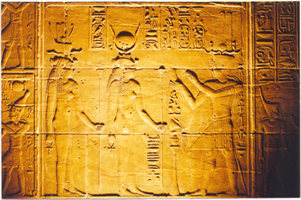
Following the death of Alexander the Great in 323 BC, his
kingdom was divided amongst his generals. Ptolemy, son of
The Ptolemies were Macedonian by descent and were often represented
as Greek rulers, as seen on the coinage, rings and stone portraits (UC 17231,
bronze finger ring with an image of Ptolemy IX). However, the Ptolemies were
also pharaohs of

The Ptolemaic queens played a very important political and
religious role during this period. They appear as queens, supporting the pharaoh
as seen on temple reliefs, but following their deaths they were then promoted
to goddesses and receive offerings from the pharaoh as seen here on this relief
from the temple of Isis at Philae where Arsinoe II stands behind the goddess
Isis and receives an offering from her husband and brother Ptolemy II Philadelphos
(see image). Later, queens were deified in this way during their lifetimes;
the statues used to represent the divine queens were different from those of
the usual time (UC 47952), both Greek and Egyptian representations had a cornucopia
or horn of plenty and often a knotted garment (UC 49884). Greek goddesses wear
a stephane (crown) rather than a royal diadem or fillet, as seen on UC 49924
and UC 49930 respectively. Egyptian goddesses can be distinguished from mortals
by the vulture headdress rather than uraeus (royal cobra) as seen on
UC 75638, where the wings are visible. Statues of the rulers and their queens
were set up in every temple throughout
Bibliography
Sites for Ptolemaic Egypt
Memphis: religious,
industrial
Saqqara: religious,
burial
Koptos: religious
Hawara: religious, burial
Koptos: religious
Copyright © 2002 University College London. All rights reserved